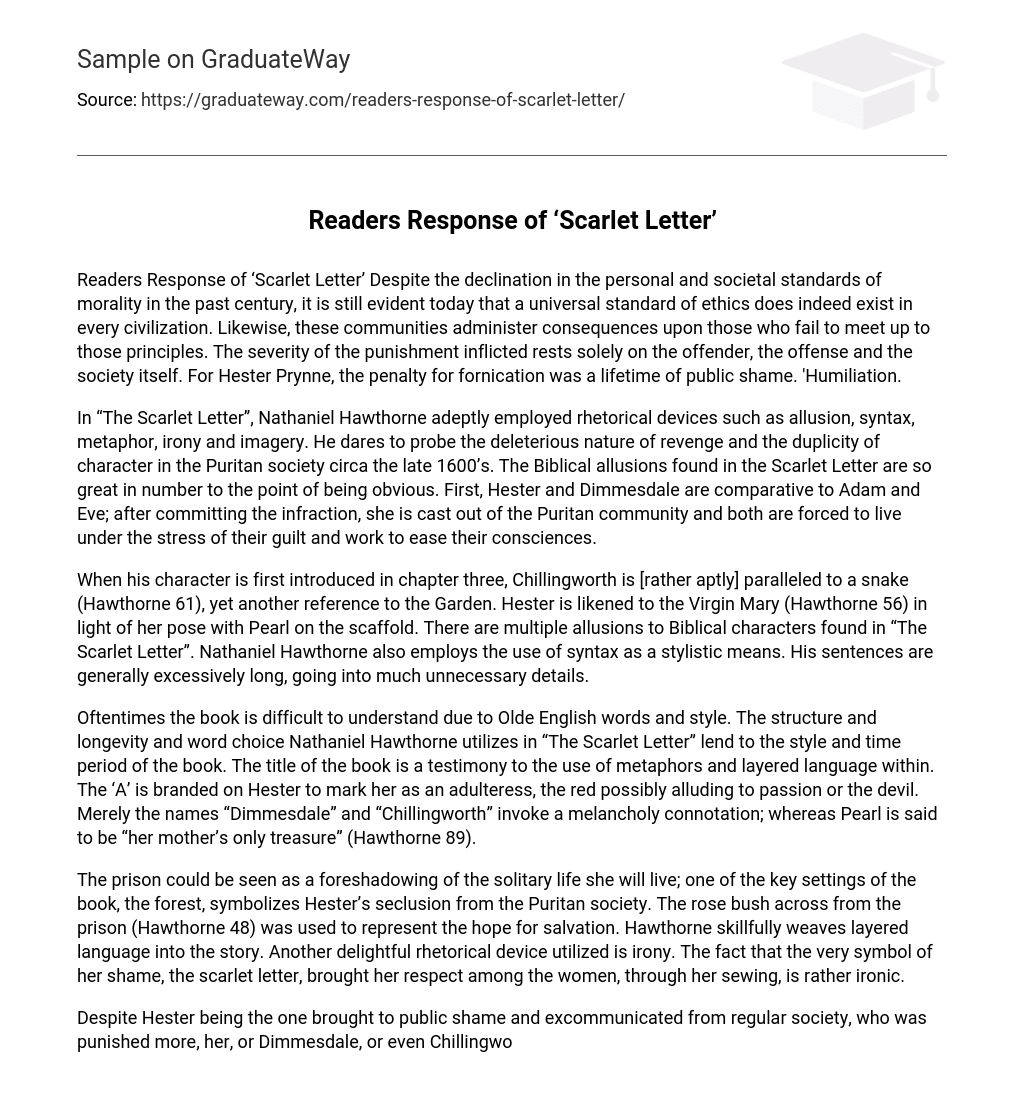Despite the decline in personal and societal morality over the past century, it is clear that every civilization still maintains a universal standard of ethics today. Similarly, communities continue to impose consequences on individuals who do not meet those principles. The severity of the punishment depends on the offender, the offense, and the society itself. In Hester Prynne’s case, her penalty for committing adultery was a lifetime of public shame and humiliation.
Nathaniel Hawthorne effectively utilized various rhetorical devices in his novel “The Scarlet Letter”, including allusion, syntax, metaphor, irony, and imagery. He bravely explores the harmful effects of revenge and the contradictory nature of individuals within the Puritan society of the late 1600s. The Scarlet Letter is filled with numerous biblical references, which are quite obvious. For instance, Hester and Dimmesdale can be seen as resembling Adam and Eve; just like their biblical counterparts, they are expelled from the Puritan community after committing a transgression and are burdened by guilt as they strive to ease their consciences.
When Chillingworth is first introduced in chapter three, he is compared to a snake, which appropriately alludes to the Garden (Hawthorne 61). Similarly, Hester is depicted as the Virgin Mary when she stands on the scaffold with Pearl (Hawthorne 56). Throughout “The Scarlet Letter,” there are various references to Biblical figures. Additionally, Nathaniel Hawthorne utilizes lengthy sentences with excessive details as a stylistic technique.
The book, “The Scarlet Letter” by Nathaniel Hawthorne, can often be challenging to understand because of its use of Olde English words and style. The structure, longevity, and word choice employed by Hawthorne in the novel align with the style and time period it represents. The title itself is a testament to the abundant use of metaphors and layered language found within the book. Hester, the protagonist, is marked with an ‘A’ as a symbol of her adultery, with the color red possibly hinting at passion or alluding to the devil. The names “Dimmesdale” and “Chillingworth” carry a sense of melancholy, while Pearl, Hester’s daughter, is described as her only cherished possession (Hawthorne 89).
The prison foreshadows the solitary life the protagonist will lead. Similarly, the forest, a prominent setting, symbolizes Hester’s seclusion from Puritan society. The rose bush opposite the prison (Hawthorne 48) represents hope for redemption. Hawthorne skillfully integrates layered language into the narrative. Additionally, irony is employed as a delightful rhetorical tool. It is ironic that the scarlet letter, which represents her shame, earns Hester respect among women due to her skilled sewing.
Despite Hester’s public shame and excommunication from society, it is debatable who suffered the most punishment – Hester, Dimmesdale, or even Chillingworth. Through her honesty and repentance, Hester found a sense of freedom that eluded Dimmesdale, who carried the weight of guilt in silence, and Chillingworth, consumed by his desire for revenge. The author employs irony as a crucial tactic, and imagery plays a significant role in “The Scarlet Letter”. Hawthorne utilizes this literary device to enhance the understanding of the characters’ unique attributes.
Imagery is employed on page sixty-one to compare Chillingworth’s face to that of a snake. The narrator describes Pearl as “flying away like a bird” to depict her movement (Hawthorne 168). Chillingworth’s interaction with Dimmesdale is expressed by the phrase “digging into the poor clergyman’s heart, like a miner searching for gold” (Hawthorne 129). Through the use of imagery, the author creates mental images and establishes connections based on character. The story takes place in Boston, Massachusetts, during the colonial era.
Hester Prynne, the main character, is found guilty of adultery, with her baby as evidence. Hester spends most of her time in the cottage and forest, but the jailhouse and pillory are also important locations. Many see Chillingworth as the antagonist because he is so consumed by his desire for revenge against Hester’s lover that he can’t see anything else. Hester faces conflicts in her relationships with others, within herself, with society, and with nature. Nathaniel Hawthorne emphasizes two major themes throughout the book that are relevant to everyone.
Hawthorne uses the character of Chillingworth to illustrate the perilous nature of revenge; Chillingworth’s intense hatred clouds his judgment and impairs his ability to think clearly. Additionally, Hawthorne highlights the dangers of having a dual persona, as exemplified by Dimmesdale. Dimmesdale’s conflicting nature ultimately leads to his downfall. Throughout the book, Hawthorne strongly cautions against negative character traits and aims to teach valuable lessons through the experiences of both characters.
In his novel “The Scarlet Letter,” Nathaniel Hawthorne employs various rhetorical devices including allusion, syntax, metaphor, irony, and imagery to enhance the narrative. The narrative contains valuable lessons, particularly emphasizing the perils of deceitful character and the destructive nature of seeking revenge.
Works Cited:
Faira. “Scarlet Letter Biblical Allusions.” OP Papers. 21 Oct. 2007. 8 Oct. 2008
Hawthorne, Nathaniel. “The Scarlet Letter”. New York: Penguin, 1983.





